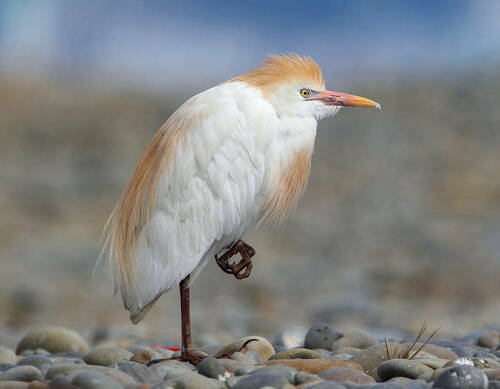
Cattle Egret
The Cattle Egret (Bubulcus ibis) is a cosmopolitan heron species found in diverse habitats across the globe. Unlike many other herons, it is often found away from water, preferring open grasslands, pastures, and agricultural fields. Its close association with grazing livestock, from which it derives its common name, is a defining characteristic. This relationship is mutually beneficial; the egret feeds on insects disturbed by the movement of cattle and other large herbivores, and the livestock may experience reduced parasite loads. The Cattle Egret's rapid expansion across continents in the 20th century makes it a notable example of avian adaptability and range extension.
46-56 cm
Length
88-96 cm
Wingspan
Least Concern
Conservation Status
Distribution
Native to parts of Africa, Asia, and Europe, the Cattle Egret has dramatically expanded its range to include North and South America, Australia, and various oceanic islands. This expansion occurred primarily in the 20th century, making it one of the most successful natural colonizations by any bird species. It is found from sea level to altitudes of up to 4,000 meters in some regions.
Lifespan
Up to 15 years in the wild, though average lifespan is likely shorter.
Cattle Egret's Habitat
Habitat Types
Grasslands, Pastures, Agricultural fields, Savannas, Wetlands (less frequently than other herons)
Climate Zones
Tropical, Subtropical, Temperate
Adaptations
The Cattle Egret's adaptability to a wide range of open habitats, coupled with its opportunistic feeding strategy, has contributed to its success. Its shorter legs and neck, compared to some other herons, are well-suited for terrestrial foraging.
Variations
Two main subspecies are generally recognized: *B. i. ibis* (Western Cattle Egret) and *B. i. coromandus* (Eastern Cattle Egret). These differ slightly in size and plumage, particularly during the breeding season.
Appearance
Breeding Plumage
Non-breeding plumage is primarily white. Breeding plumage includes buff-colored plumes on the head, breast, and back. The bill and legs also become brighter in color during breeding.
Seasonal Feather Changes
Significant changes in plumage color occur between breeding and non-breeding seasons, as described above.
Sex Based Plumage Differences
Males and females have similar plumage, though males may have slightly brighter or more extensive buff plumes during breeding.
Notable Features
Relatively short, thick neck compared to other herons, Yellow or reddish bill (depending on season and subspecies), Buff plumes during breeding season
Diet and Feeding
Primary Foods
Insects, Spiders, Grasshoppers, Crickets, Flies, Moths, Occasionally frogs, small fish, and earthworms
Foraging Behavior
Cattle Egrets often forage in close association with grazing animals, capturing prey disturbed by the animals' movement. They may also forage independently in fields and grasslands, walking slowly and pecking at prey.
Specializations
Their foraging strategy, closely tied to livestock, is a key specialization that distinguishes them from many other heron species.
Seasonal Diet Variations
Diet composition may vary depending on prey availability, which can be influenced by season and location. For example, they may consume more frogs and fish during wetter periods.
Behavior
Social Structure
Highly social, often found in flocks, especially during foraging and roosting. They form large breeding colonies, often mixed with other species.
Communication
Variety of croaks and calls, Visual displays, particularly during courtship and territorial defense
Migration
Some populations are migratory, moving in response to seasonal changes in rainfall and food availability. Others are resident or partially migratory.
Territorial or Group Behaviors
While generally social, Cattle Egrets may defend small feeding territories around grazing animals. Breeding colonies are often densely packed, with nests close together.
Conservation
Threats
Habitat loss (particularly wetlands and grasslands), Pesticide use (reducing prey availability), Climate change (altering rainfall patterns and breeding success), Human disturbance at breeding colonies
Protection Programs
Protected under various international agreements, such as the Migratory Bird Treaty Act in North America., Conservation of wetlands and grasslands is crucial for their long-term survival.
Local National Laws
Protected in many countries through national legislation.
Population Trend
Generally stable, although some local populations may be declining due to habitat loss or other threats.
Population Estimates
Global population estimated to be in the millions, making it one of the most abundant heron species.
Interesting Facts
Rapid Colonization
The Cattle Egret's natural expansion across continents in the 20th century is one of the most remarkable examples of avian range expansion.
Commensal Relationship
Their close association with grazing animals is a classic example of commensalism, where one species benefits (the egret) and the other is neither significantly harmed nor helped (the livestock).
Cosmopolitan Distribution
Found on every continent except Antarctica.
Faqs about Cattle Egret
Why are they called Cattle Egrets?
They are named for their habit of foraging near cattle and other livestock, feeding on insects disturbed by the animals.
Do they only eat insects?
While insects form the majority of their diet, they also eat other small invertebrates, and occasionally small vertebrates like frogs and fish.
Are they related to other egrets?
Yes, they belong to the heron family (Ardeidae), which includes other egrets, herons, and bitterns.
Are Cattle Egrets endangered?
No, the Cattle Egret is classified as 'Least Concern' by the IUCN due to its large population and wide distribution. However, local populations may face threats.
Copyright @ Nature Style Limited. All Rights Reserved.
 English
English